ENVIRONMENT AND ENERGY
Project SHAKEIT
Principal Investigator:
Andrea Morelli
Affiliation:
Istituto Nazionale di Geofisica e Vulcanologia, Bologna (Italy)
Local Project ID:
pr86vo
HPC Platform used:
SuperMUC of LRZ
Date published:
Ground shaking due to an earthquake not only depends on the energy radiated at the source but also on propagation effects and amplification due to the response of geological structures. A further step in the assessment of seismic hazard, beyond the evaluation of the earthquake generation potential, requires then a detailed knowledge of the local Earth structure and of its effects on the seismic wave field. The challenge for project SHAKEIT, which was enabled through the Partnership for Advanced Computing in Europe (PRACE) on HPC system SuperMUC of LRZ, has then been, first, to derive a good model of the geological structure of the Earth crust in our region and, second, to use this model to study the response of the Earth to plausible earthquakes as inferred from historical catalogues.
For the first point, a team of scientists under leadership of Professor Andrea Morelli of the Istituto Nazionale di Geofisica e Vulcanologia in Bologna, Italy, constructed a crustal model by a geostatistical approach, merging information from prospections carried on in the past for hydrocarbon search. The scientists then had to adjust some specific seismic parameters of the model. This was done examining the space of possible models with a sampling technique (Latin hypercube) and selecting the fittest model as the one best reproducing actual seismograms recorded for recent quakes. Having validated the model, the researchers moved on to simulate ground shaking for populations of earthquake sources that represent the uncertainty of historical sources.
Simulation of the seismic wave field in realistic 3D geological structures is possible nowadays but requires extensive computational resources. Each of the forward runs may not necessarily be a huge task by itself, but appraising uncertainties (in model parameter values, in earthquake source properties) involves running a massive number of correlated individual runs, and this is only possible on a Tier-0 high-performance infrastructure. The research team’s workflow is quite successful in modelling seismic signal with frequency up to 0.5 Hz, relevant for the response of high-rise buildings, and soil liquefaction processes. This study builds the basis for a physics-based approach to seismic hazard estimates in northern Italy. There is still need to increase model resolution to reach seismic frequencies up to 1 Hz, and then to integrate a stochastic algorithm in a hybrid approach to synthesise even higher frequencies, relevant for low-rise buildings. Account for geographical variations of ground shaking permits more accurate assessment than standard distance-dependent empirical relations, and is very relevant for northern Italy. The final goal of these studies have high interest for the society, as it can contribute to more precise seismic hazard estimates.
Research team: A. Morelli (Lead scientist), I. Molinari, P. Danecek, P. Legovini, A. Berbellini – Istituto Nazionale di Geofisica e Vulcanologia, P. Basini - Toronto University, Canada.
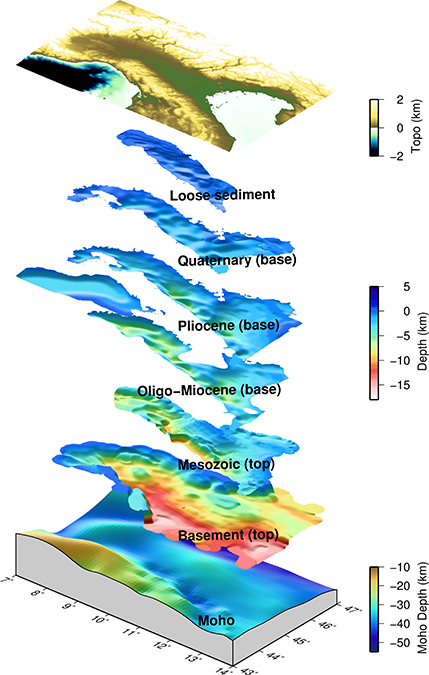
D view of the model interfaces within the Po Plain basin. Copyright: © Istituto Nazionale di Geofisica e Vulcanologia, Bologna/Italy
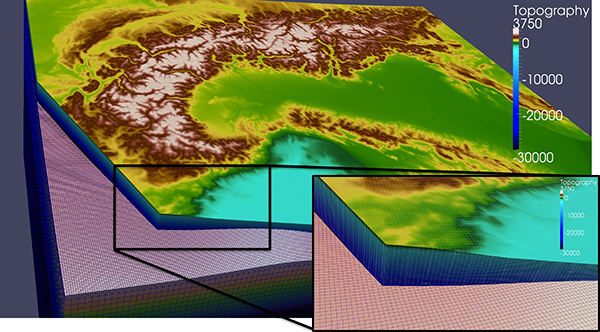
Mesh of the crust and the mantle, coloured as a function of topography. The mesh honours the topography of free surface and crust/mantle boundary (Moho). Copyright: © Istituto Nazionale di Geofisica e Vulcanologia, Bologna/Italy
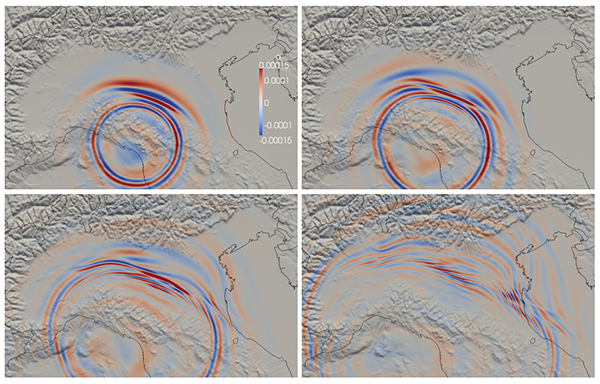
Snapshots at 30s, 50s, 70s and 100 s of the simulation of the Mw=5.2 June 21, 2013, earthquake. The effect of the basin structure is clearly apparent when the wave front passes the ESE-WNW-trending boundary with the mountain front. Copyright: © Istituto Nazionale di Geofisica e Vulcanologia, Bologna/Italy
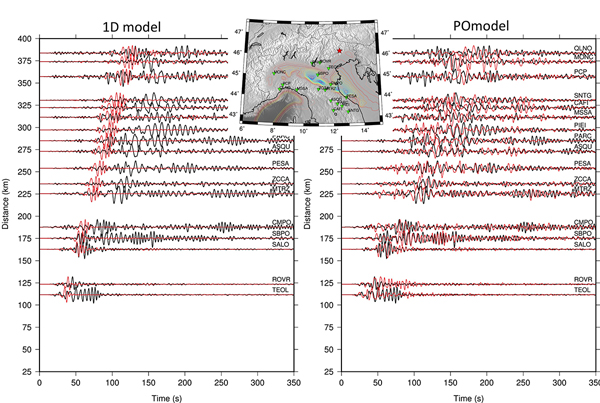
Comparison between data (black) and synthetics (red) calculated in a 1D model (left) and in our 3D model (right) for an earthquake of magnitude 4.5 occurred in Eastern Alps. The map shows the epicentre (star), the seismographic stations (green triangles) and the depth of the Pliocene sediment. Copyright: © Istituto Nazionale di Geofisica e Vulcanologia, Bologna/Italy

Duration of seismograms, as a function of distance. Each point represents a seismogram. Black dots, actual data. Green dots, seismograms computed in the 1D model. Red dots: seismograms computed for the large-scale 3D reference model. Blue dots: seismograms computed for the new 3D model. The new 3D model reproduces longer duration seismograms much better. Copyright: © Istituto Nazionale di Geofisica e Vulcanologia, Bologna/Italy
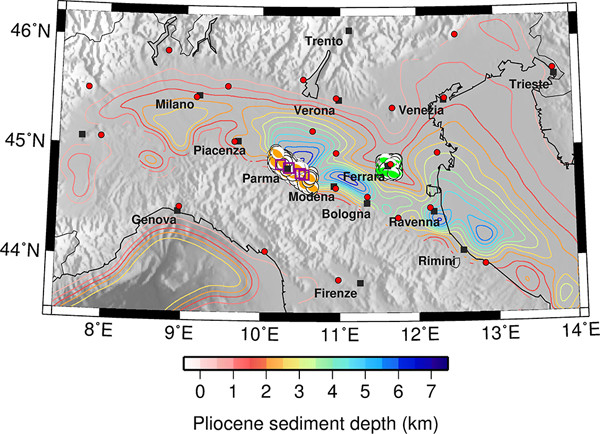
Clusters of seismic sources sampling the uncertainty deriving from historical records. The earthquake near the city of Ferrara occurred in 1570, while several individual events occurred in the belt between the cities of Modena and Parma in 1438, 1831, 1832, 1971. Each cluster includes 200 samples. Isolines in the background indicate the thickness of Pliocene sediments, an important factor for ground motion amplification. Copyright: © Istituto Nazionale di Geofisica e Vulcanologia, Bologna/Italy
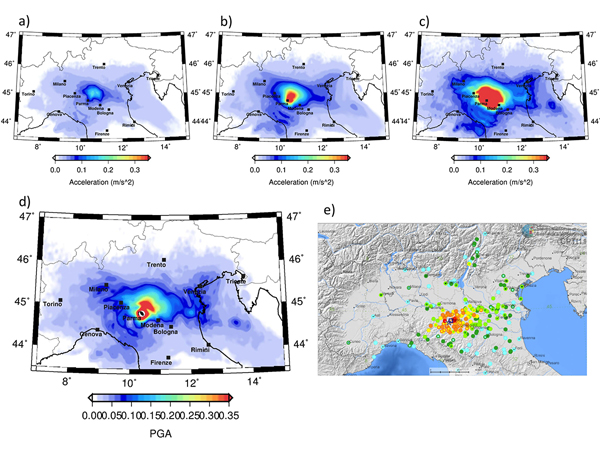
(a) Minimum, (b) median, (c) maximum peak ground acceleration expected in the whole plane for waves with period longer than 2 seconds generated by the ensemble of 200 possible sources for the Parma earthquake. (d) PGA for one of the 200 scenarios and (e) a qualitative comparison with the macro seismic damages intensity recorded for an earthquake occurred in the same area in the 1971. Copyright: © Istituto Nazionale di Geofisica e Vulcanologia, Bologna/Italy
Scientific Contact:
Professor Andrea Morelli
Sezione di Bologna, Istituto Nazionale di Geofisica e Vulcanologia
Via Donato Creti 12, I-40128 Bologna/Italy
e-mail: andrea.morelli@bo.ingv.it